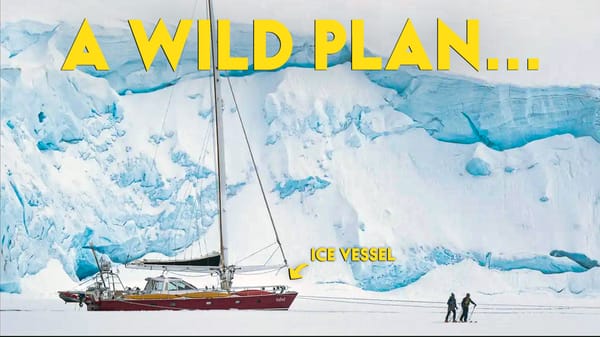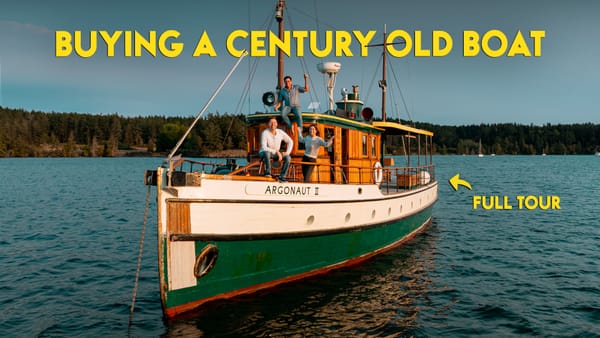RV Solar Tilting: Is It Really Worth It To Tilt The Panels?
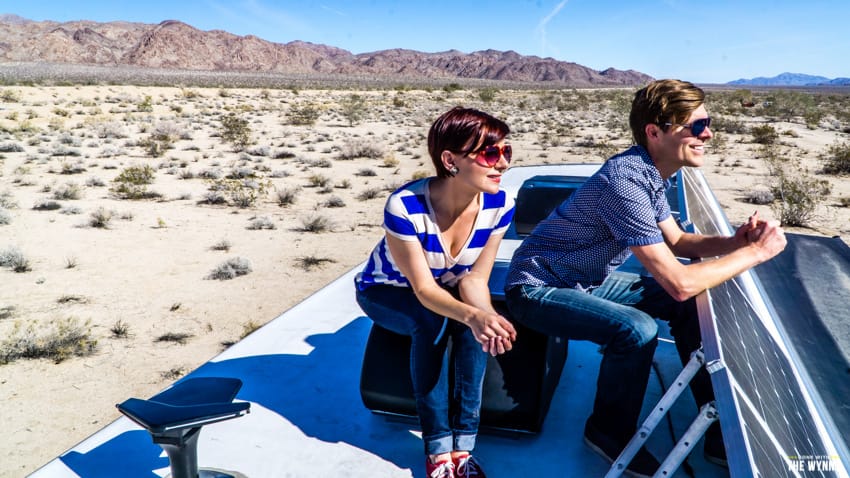
We’ve had a few different RV solar setups over the years but we never tilted our panels. People would watch our solar videos and say ‘you should tilt your solar panels; you’ll get way more power.’ Our excuses have always been: we move too often; we don’t want to get up on the roof that much or it’s only helpful a couple months out of the year.
With our most recent solar set up we decided to put our lazy excuses aside, install the tilting kit, test it out and see if it’s really worth the hassle.
As you can see from the video, tilting made a huge difference at our wild camping spot. But…just because we got a nice boost doesn’t mean it’s a clear, “yes tilting is worth it” answer for everyone. Things like how often you wild camp, what time of year you camp and where you camp all come into play.
Our RV Solar Setup
Before I dive in too deep, here is the “off the cord” gear we are working with. Click on the links for more info:
- GoPower! Solar All Electric Kit
- Magnum 3000 watt Pure Sine Hybrid Inverter
- Tilting Kit
- Overview of All of Our Technology and Mods
I’ve spent days (probably weeks) researching online, emailing questions to our solar manufacturer, our solar installers and friends with solar on their RV roofs. I wanted to have a solid basic understanding so I could make an educated decision on whether or not it’s worth it to tilt and then share what I’ve learned with you.
I’ve made my best attempt to answer all the questions I could think of while keeping it simple.
After all, the idea is to help you get the most out of your RV solar panels, not dive into overwhelming detail. We’ll see if I can accomplish that goal or not.
Our RV Solar Tilting Test Results
Solar Tilting Test Location
- • Location Name: Joshua Tree BLM South
- • Our EXACT GPS coordinates: 33.673887, -115.799702
- • Nearest Large City: Indio, California
- • Dates of Stay: January 11 – January 24, 2016
- • Panel Face Direction: Directly South
The Solar Output During Our Stay
- • 37 amps – Highest power reading from our Solar Panels while lying flat on the roof (average of 6.17 amps per panel)
- • 57 amps – Highest power reading from our Solar Panels while tilted (Average of 9.5 amps per panel)
- • 20 amps – The difference between flat and tilted solar panels. To get a similar amount of solar power without tilting we would need 3 additional solar panels.
What We Could Do Better
Tilt Angle –The recommended tilt angle for January at that GPS location was 59° (3° more degrees than our tilt).
Panel Face Direction –True South based on our GPS coordinates was slightly southwest so we should have moved the RV a tiny bit to compensate for this.
What Are The Upsides of Tilting RV Solar Panels?
• More Solar Power! This is the main reason you tilt your solar panels. With a proper tilting kit on your RV you will bring in around 40% more solar power during the Winter months.• Another advantage is easier access to the roof for weather proofing inspection, solar panel wire inspection & roof repairs.• Tilting helps the panels “breathe” which may help keep them cooler when the sun is beating down on them.
What Are the Downsides of Tilting RV Solar Panels?Some of these scenarios are highly unlikely but they are things I think about none the less.
• Climbing up the ladder can be dangerous and my mathematical thoughts about this is: the more I climb up that ladder the greater my chances are of falling and hurting myself, which wouldn’t be good if we’re 100+ miles from the nearest hospital.
• Weather can increase the risk. A morning dew on the roof makes it extremely slippery as does rain and snow.
• Lowering the panels in wind is stressful. The day after filming this video we reached our 14 day stay limit so it was time to leave. Mother Nature decided to whip the winds up to an aggressive 30+mph and here I am on the roof with one hand trying to unscrew the panel from the tilting arm and the other hand trying to keep the solar panel from getting ripped off the roof when the bolt finally disconnects from the wingnut.
• Driving Off with the panels up would be an expensive and disastrous mistake. I think to myself there’s no way I’ll forget…but if there was an emergency and we needed to move the RV in a rush I could see myself doing just that! It’s not likely but it could happen.
• With easy to remove wing nuts it might be easier for a culprit to steal the panels off your roof. This isn’t likely to happen while you’re in the RV, but if you store your RV for extended periods of time, or park and leave your RV it is a possibility.
• When I’m climbing up the ladder with the tilting arms in hand I think to myself what if accidentally gouge one of these into the side of the RV, that would be bad news for the paint job!
• Maybe it’s our install job or our roof type but I feel each time I tilt the panels I’m putting extra stress on the mounting feet, the screws and the Dicor sealant that holds those mounting feet into the roof.
Is It Really Worth It to Tilt My RV Solar Panels?
Back to that original question! The answer is yes…and no. After tilting for nearly a year, here’s the debate from my perspective:
•Tilting is TOTALLY worth it:Who doesn’t want to get the most bang for their buck? 40% more “free” power in winter is hard to say no to. (Granted it’s not free if you consider the cost of 6 tilting kits at $80 each. It’s almost the same price as adding another solar panel. Perhaps a DIY tilting kit from the hardware store would be cheaper?)
•Tilting is NOT worth it:
We have room on our roof for more panels. Current price for a 160 Watt expansion panel is $630. We could install two more panels for less than $1,500 effectively increasing our summer solar output by more than 30% and nearly matching our tilted winter solar output. I’d no longer have to climb on the roof each time we park, potentially scratch my RV while climbing the ladder with the tilting arms in hand, or worry about the extra stress on my roof or mounting brackets.
Based on Experience, What Do We Recommend?
We only tilt in the winter and only when we’re camping in one location for more than 3 days. If you are a serious winter wild camper then yes, invest in a good tilting kit and maximize your solar power output. If you’re not a winter camper and move every 3-5 days then don’t bother with a tilting kit, it’s not worth the risk, time investment or the hassle.
What about an automated tilting kit or tracking system?An automated tracking system is still a pipe dream for most RVers, they’re expensive, non-aerodynamic, extremely heavy and too large for an RV roof. Manual tilting is still the best option for most RVers. Our tilting kit is comprised of 2 aluminum bars, 2 bolts and 2 wing nuts. Come to find out our kit is better than most because with the multiple holes and two bars we can adjust our solar panels to just about any angle for maximum sun exposure based on the season.
Here is the Amazon Link to our exact solar tilting kit, you will need to order one kit for each solar panel: Tilt Mount Kit http://amzn.to/1NIJLwk
How Does the Season Effect Solar Power & Tilting Angles?Winter – The sun sits low on the horizon and the days are short. Tilting can increase solar output by 40%
Fall & Spring – The sun is getting higher on the horizon and the days are getting longer. Tilting can increase solar output by 20%
Summer – The sun is high and the days are long. Tilting provides little to no benefit, in fact if you tilt you may get less solar power
How Does My Latitude Effect the Solar Power & Tilting Angle?• The further south, the closer you are to the equator and the more solar power you should be able to capture.
• I can’t think of a simple way to explain this so I’ll give an example that should relate to many RVers that travel on the Western side of North America.
o January in Yuma Arizona: 10 hours of sunlight; Solar Panel Tilt Angle 58° (5.84 kWh/m2/day)o January in Seattle Washington: 9 hours of sunlight; Solar Panel Tilt Angle 63° (2.36 kWh/m2/day)
• Results will be similar on the East coast, for example Jacksonville Florida vs. Bangor Maine.
• If you’re wondering what the heck “kWh/m2/day” is you’re not alone. It is called “solar insolation” and it’s the measurement that refers to the amount of solar energy that can be captured. Notice in my January example above Yuma has the potential to bring in over double the amount of solar power compared to Seattle.
What is the best tilting Angle for My Solar Panels?Finding the best tilting angle for your solar panels is based 100% on your GPS coordinates and the season. I use the NASA Solar Energy Site to calculate my solar panel tilt angle. At first glance it seems extremely complicated, but here is a step-by-step example of how I calculated the optimum tilt for our Joshua Tree BLM South camping location:
1. Enter your Latitude and Longitude in the boxes on the left side of the screen. Click the “submit” button on the center of the screen.

2. In the 4th box from the top titled “Parameters for Tilted Solar Panels” select the option called “Maximum radiation for equator-pointed tilted surfaces”. Click the “Submit” button at the bottom center of the screen.
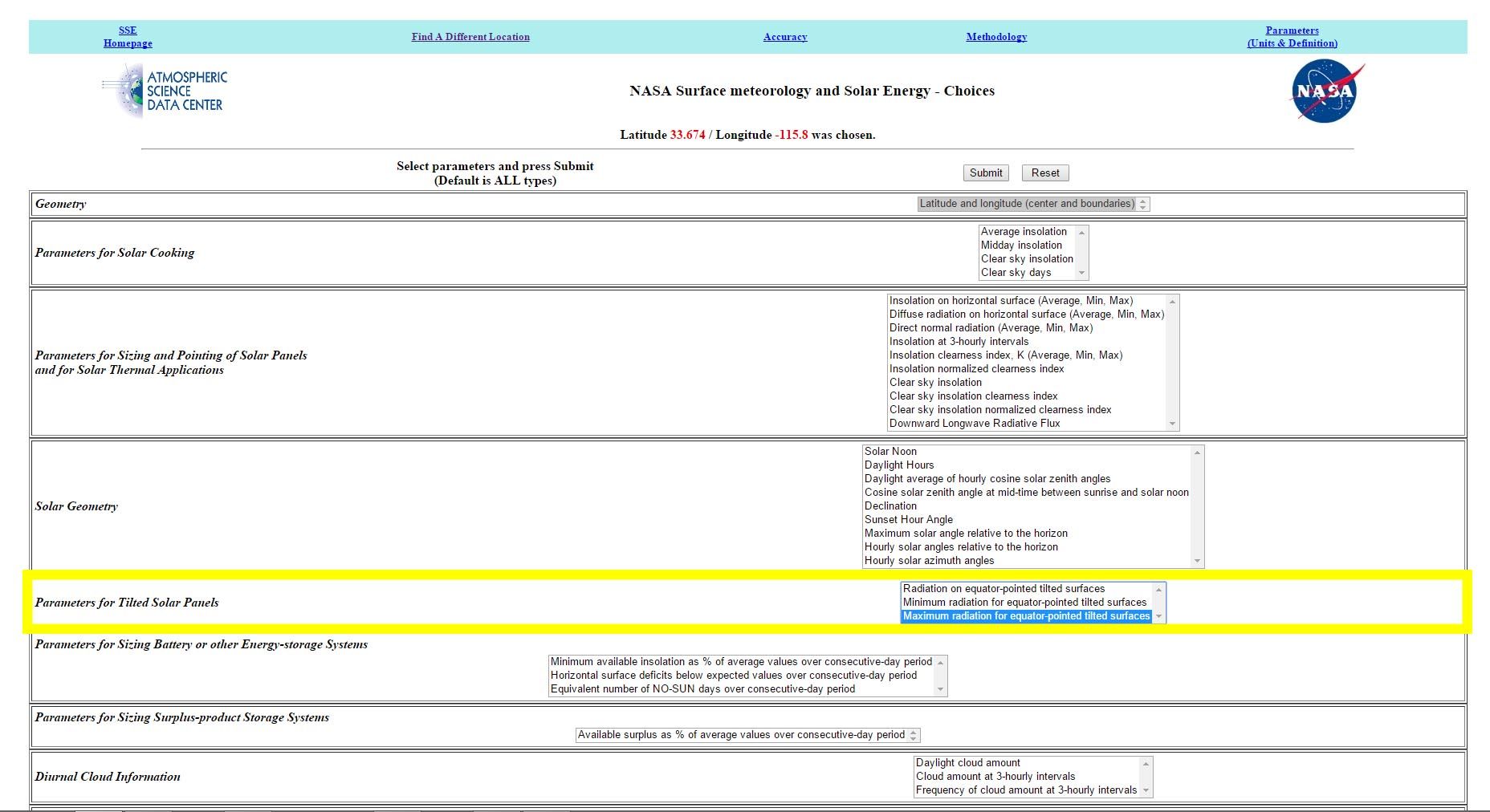
3. At the bottom of the table you can see the potential amount of solar power and the optimum angle for tilting. For example, at this location in January the optimal angle of tilt is 59° for maximum solar power. In June it’s best for the solar panels to be completely flat.
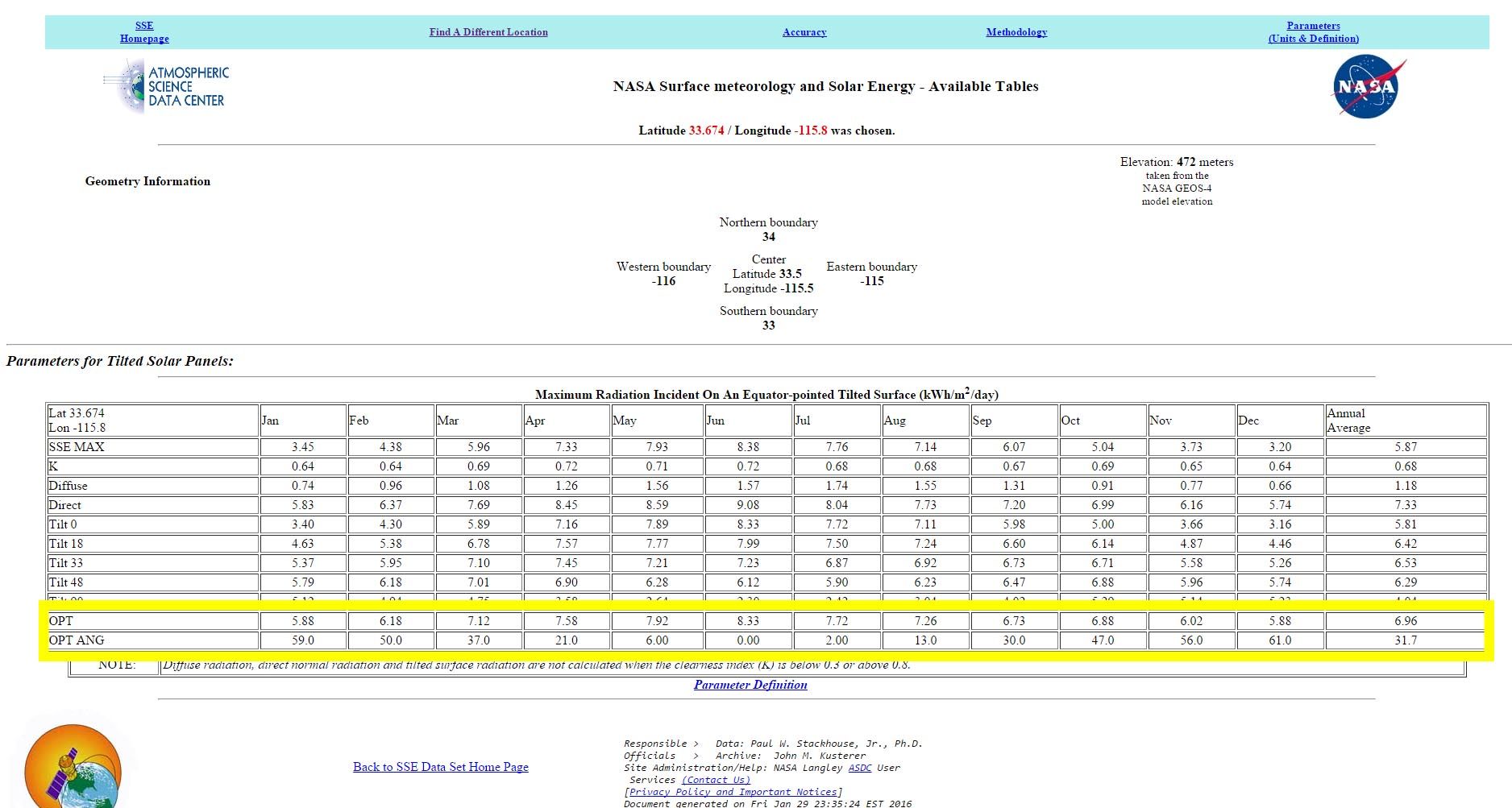
4. As a guide the higher the number the more solar power you will capture. For example, in January at this location, exposure on a flat (Tilt 0) panel will be 3.40 kWh/m2/day. The exposure on a 33° tilt will be 5.37 kWh/m2/day. The exposure on the recommended 59° tilt will be 5.88 kWh/m2/day, that’s 42% more power than what the flat panel will produce.
Which Direction do I park the RV?• In North America you want to generally point your solar panels south, towards the equator.
• If you want to get the maximum power output from your panels, you’ll want to point your panels “true south”.
• For us, our solar panels are on the driver’s side of the RV so we point our windshield facing west.
What About Shadows from the Tilted Panels?Shadows are your enemy. Do not place solar panels too close together otherwise they may shade each other when tilted. This is one of the reasons we chose the linear side-by-side install on our RV solar setup.
Additional Resources – Learn More and Get Every Amp Out of Your Solar Panels.
Here are a few sources for Expert Solar Energy Information, the information is extremely technical and I’m not even going to try and pretend like I grasp half of it.
• NASA Surface Meteorology and Solar Energy – At first this site was completely over my head (I received the link from the engineers at GoPower!). After a phone conversation with GoPower! I now understand a small portion of the site that helps me calculate the best solar tilt angle based on my GPS Location and month of the year. I figure since it’s NASA they probably have this sorta thing figured out.
• Sun Earth Tools – Sun Position – This website has a ton of info about sun position, solar, sundials, etc. I don’t understand 90% of it, but you’re free to click around and totally geek out if that’s your thing.
• NOAA Magnetic Field Calculator – Find True South (base on Magnetic Declination) by typing in your GPS location.
• National Renewable Energy Lab – Solar Radiation and Insolation Maps for the USA.
Obviously it’s all a personal decision based on too many factors for me to provide a definitive answer. So, what is your take? Together maybe we can simplify and demystify the solar tilting process. If something clicks for you let me know. If something has you more confused than ever let us know and we’ll try to address it. Thanks so much for reading!

